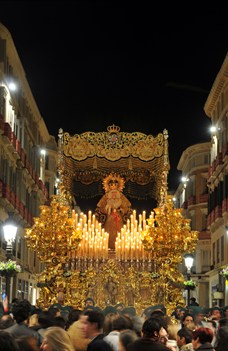The Tronos of Holy Week in Malaga
 Between the late sixteenth and early seventeenth century, the theatrical performances that took place during Holy Week underwent a profound change. In compliance with the directives of the Council of Trent, real people were replaced by statues and groups of statues depicting Christ, the Virgin of Sorrows, or scenes from the Passion. In Spain, these images were placed on finely decorated palanquins or wooden supports, the famous pasos, which in Italy are variously called Vare or Misteri, a name that, by extension, indicates both the supporting structure and the processional “machine” as a whole.
Between the late sixteenth and early seventeenth century, the theatrical performances that took place during Holy Week underwent a profound change. In compliance with the directives of the Council of Trent, real people were replaced by statues and groups of statues depicting Christ, the Virgin of Sorrows, or scenes from the Passion. In Spain, these images were placed on finely decorated palanquins or wooden supports, the famous pasos, which in Italy are variously called Vare or Misteri, a name that, by extension, indicates both the supporting structure and the processional “machine” as a whole.
In Malaga, the pasos are better known as tronos, from the name of the stands (thrones), on which the statues are placed in the churches. They are gorgeous wooden chariots designed to carry sacred images of Holy Week in procession. Today, a throne can weigh up to five tons and require more than two hundred carriers. Usually, each Brotherhood owns two: one dedicated to Christ or inspired by a scene from the Passion (also called Misterio), the other depicting Our Lady of Sorrows portrayed in a regal pose (surrounded by a dense crown of candles and white flowers) topped by a magnificent canopy (the palio).
